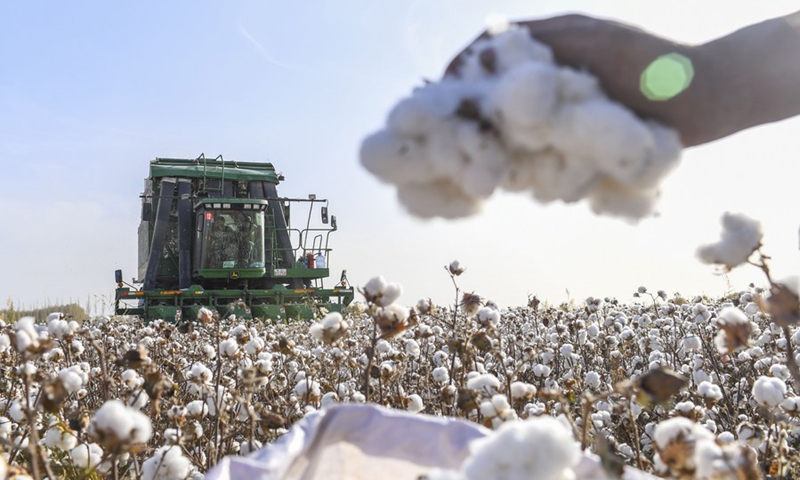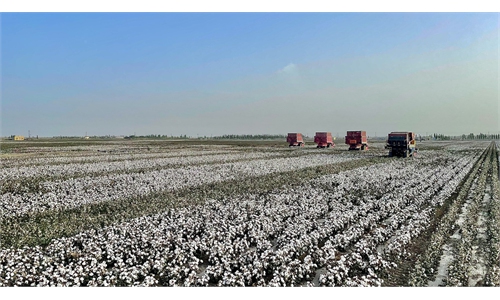Xinjiang cotton sees a bumper year with higher yields, income for farmers despite US crackdown

A cotton picking machine moves in a cotton field in Dolatbag Town of Bachu County, northwest China's Xinjiang Uygur Autonomous Region. File photo: Xinhua
The cotton harvest from more than 30 million mu (2 million hectares) of land has been acquired in Northwest China's Xinjiang Uygur Autonomous Region, as the buying season is drawing to a close, with higher crop yields and incomes for cotton farmers indicating a prosperous industry, despite slander and crackdown by the US, industry insiders said."Recent changes in the international trade situation have brought new challenges to the development of the cotton industry. But changes in external factors will not hinder the high-quality, sustainable development of China's cotton industry," Wang Jianhong, vice president and secretary general of the China Cotton Association (CCA), told the Economic Daily on Saturday.
The CCA said last week that the "domestic cotton price spread based upon quality," and the cotton acquisition season was drawing to a close.
Industry insiders said that the mechanization rate of cotton picking in Xinjiang has continued to increase, and the quality of Xinjiang cotton is also rising with thorough, fine management from seed sifting to planting and fertilizing. The efficiency of the industry chain has also been optimized, despite the US' crackdown campaign.
Chinese consumers can buy clothes in March made from Xinjiang cotton harvested in November 2021, said a member enterprise of the China Cotton Industry Alliance (CCIA).
According to the CCIA, it only takes 90 days from cotton harvesting to fabric completion, which would directly enter the assembly line of clothing enterprises.
China's total output of cotton reached 5.95 million tons in the 2020-2021 harvest year, according to the China Cotton Textile Association (CCTA).
Of the total, 5.13 million tons came from Xinjiang, accounting for 87 percent of domestic cotton output in 2021, statistics from the National Bureau of Statistics (NBS) showed.
Total demand for cotton in China is about 7.8 million tons, with about 1.85 million tons relying on imports, mainly from India, Australia and other countries, read a report released by the CCTA in December.
According to the NBS, Xinjiang's cotton yield per hectare reached 2,046.4 kilograms in 2021, and the income of cotton-planting farmers was more than 1,500 yuan per mu ($15.6 per hectare).
A farmer in Xinjiang told the Global Times that his net income is more than 600,000 yuan ($94,077) from about 600 mu of cotton plants every year.
Zhang Jie, manager of a textile company in Xinjiang, told the Global Times that the company's cotton fields have mechanized the planting process, making cotton planting easier and more efficient, with increasing incomes.
"We sow cotton with the BeiDou Navigation Satellite System, water it with automatic drip irrigation, and pick it with machines," said Zhang.
Chen Minhong, a cotton farmer in Xinjiang's Yuli county, got a taste of the benefits of 5G technology in 2021, the CCTA reported.
With the introduction of intelligent equipment, Chen's field of more than 1,000 mu has realized intelligent cultivation, sowing, fertilization and picking, which has helped increase the yield to 400 kilograms per mu from 350 kilograms.
From 2019 to December 2021, a total of 19,343 5G base stations were built in Xinjiang, according to the Communications Administration of Xinjiang.
"Machine picking costs 150 yuan per mu, averaging 50 yuan per kilogram. The cotton production area in northern Xinjiang has realized 100 percent machine picking, and the machine picking rate in southern Xinjiang has reached 70 percent," said Cao Huiqing, president of the Department of Cotton Farmers at the CCTA, in December.
In recent years, Xinjiang cotton has mainly supplied large domestic textile enterprises, whose factories moved to Xinjiang, read a CCTA report.
Xinjiang cotton accounts for 67 percent of domestic consumption.
"Xinjiang cotton, imported cotton and imported cotton yarn are all used in cotton textiles for export. The proportion of Xinjiang cotton is probably at least 50 percent of all textiles exported from China," a staffer at the Shanghai International Cotton Exchange told the Global Times on Sunday.
While domestic textile mills have strong demand for Xinjiang cotton, export-oriented textile enterprises indeed face the challenges posed by the US crackdown, industry insiders noted.
They also said that in order to deal with the uncertainties and risks of the international market, China's large garment enterprises have built factories in Southeast Asia, or more distant locations such as Mexico.
According to a Chinese textile enterprise, which declined to be identified, it has built production bases in China's Xinjiang region and Vietnam.
Its factories in Xinjiang serve Chinese enterprises, while the factories in Vietnam serve overseas customers.



